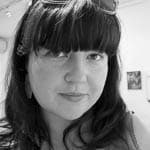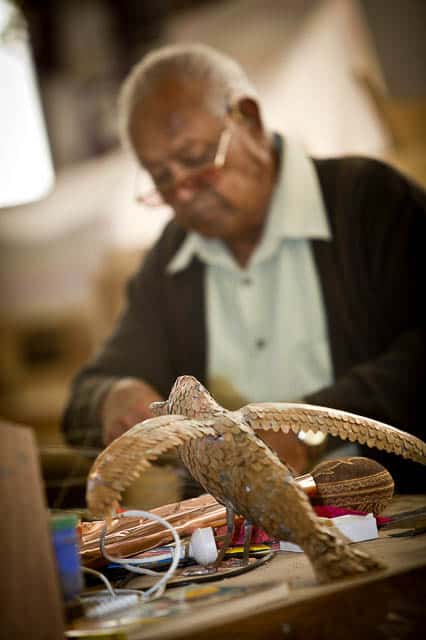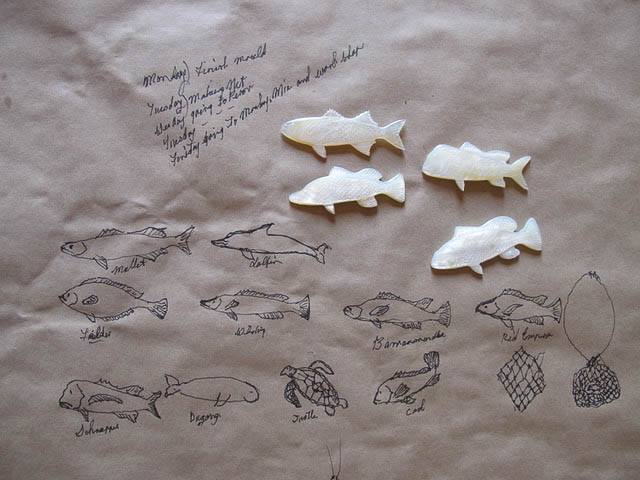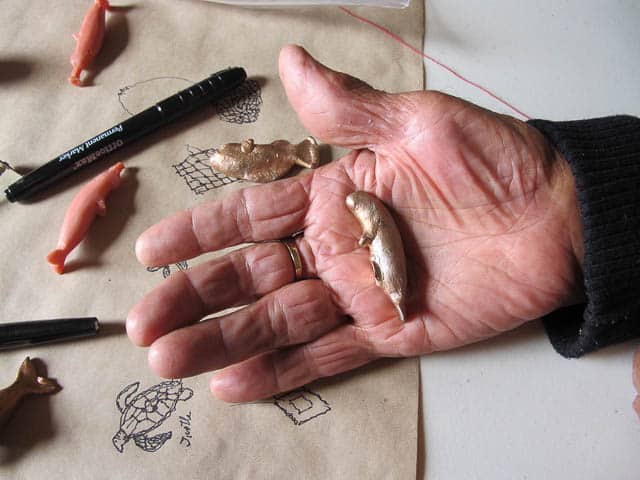- Concept development with Jimmy. (size variable), photo Helena Bogucki
- Concept development with Jimmy. (size variable), photo Helena Bogucki
- Concept development with Jimmy. (size- variable), photo- Helena Bogucki
- Materials and concept development with Jimmy. Brown paper, inl, carved pearl shell (size variable), photo Helena Bogucki
- Developing cast brass dugongs with Jimmy. (size- variable), photo- Helena Bogucki
There was a time that I introduced myself as a fly-in fly-out jeweller. I am based in Perth Western Australia and my contemporary jewellery practice was momentarily part of the mining boom. Beginning in 2013 I had the opportunity to work and develop connections with regional Western Australian communities in the Pilbara, Shark Bay and Carnarvon in relation to my contemporary jewellery practice. A mentorship with 90-year-old Jimmy Poland a senior Malgana man and artist of Gutharraguda (Shark Bay) Country has defined the way I choose to make and explore narrative in my work while engaging with communities to facilitate the safekeeping of their stories.
We seek the opportunity to be connected to place. Our homes, our landscape and our stories are ways in which we connect. We want our lives to mean something, to leave a legacy and tell the stories that have shaped our environments. These connections are more obvious to some and propose a more direct interaction with the space in which they occupy. During the 18 months that I worked with Jimmy, I developed an understanding of his country and his role in the landscape that he has helped nurture and preserve.
A colleague and friend, Sarah Trant, who worked extensively in remote communities in Western Australia facilitating and managing community programs presented me with the opportunity to meet Jimmy. Sarah introduced me to many visiting artists at my studio space at the Midland Atelier (Perth, Western Australia) and I was always happy to share a conversation and knowledge.
During our first meeting, Jimmy and I discovered we both enjoy exploring new materials, we like a challenge and we love to work with a cup of tea on our benches. Sarah saw the potential in a mentorship project between myself and Jimmy and set the wheels in motion, seeking funding and developing a project that would document Jimmy’s role in his community and explore new skills and materials that would benefit his arts practice. FORM also saw the potential of this project and supported us in the development of the mentorship, travel, exhibition and publication costs.
Jimmy shared stories with me about how he began carving pearl shell jewellery, emu eggs and boab nuts when he retired from commercial fishing. His father before him carved emu eggs that documented local events and this is a skill that Jimmy taught himself when he was presented with a pocketknife and a single emu egg to help him pass the time during retirement. His tales were often about childhood adventures across sand dunes, his diverse knowledge of the local ocean tides and the ever-evolving landscape of the townsite he calls home.
We travelled up and down the coast of Western Australia between Perth and Gutharraguda with our studio essentials to document Jimmy’s stories in the work that he makes. Via the air and land, we gathered copper, bronze, silver, bone, shell and wood to make contemporary jewellery and objects that share his history and the mentorship. We spent time exploring new ways to quickly generate ideas: photocopies, clay, paint, wax and string—any medium that we could manipulate to provide a snapshot of one of his stories. This process was a rare opportunity for Jimmy to expand his creative skills. We played in the studio. We cut in the studio. We glued. And we challenged our materials. Graphite pencil on copper provided the beginning elements for a series of layered metal baskets to nest his carved boab nuts. Bones carved to create miniature dugongs. Sheets of copper folded and sculpted became seabirds and fish.
Jimmy’s work is renowned within his own community and frequently collected by travellers passing through the region. Word of mouth promotion would often lead to an audience whilst we worked at his home or at the local community centre in Gutharraguda. We worked together to document his stories that connect him to his country through his carving and storytelling. A lifetime of stories is documented on fragile surfaces of shell. Stories of local fishing spots, times of hardship, and overwhelmingly stories of family and adventure. The delicate lines carved in to the refined organic surfaces depict local flora and fauna. The feathers of a sea eagle carved in detail alongside an intricate depiction of local fish.
Our traditional interpretation of communication during the mentorship process was challenged. Due to his hearing loss, we developed a form of nonverbal communication to express our ideas. We developed a way of working together that formed our own terms of communication that are unique to the evolution of the mentorship. Sometimes we made notes in pen or drew small sketches on brown paper to plan our day in the studio together. These paper conversations are also historical markers that denote elements of Jimmy’s stories in Gutharraguda and reminders of themes that would be conveyed in bone, shell and metal.
Through their actions, our hands communicated processes and ways to develop ideas. Our hands often danced around an object as we discussed the lines of the carved form or the negative space that the piece occupies. After 18 months we were able to share a glance that spoke more clearly than our words.
The longer we worked together in our transportable studio, the fewer words we needed. Our hands said more as we communicated to each other with small pieces of metal and bone; manipulating the copper into delicately curved forms and engraving the shapes of scales into the surface of pearl shell. I made small objects and jewellery alongside Jimmy as he worked and we reflected on the making process, an opportunity that is only realised in the silence of our actions.
The resulting works and extensive documentation of the project were showcased in the Pieces of Gutharraguda (Shark Bay): Jimmy Poland exhibition. The opening event in his hometown Denham was an exciting experience for all involved. Jimmy’s family and friends joined him to share the legacy of his storytelling and creative practice. The exhibition toured to several Western Australian regional galleries and Perth.
At the beginning of the project, I was concerned about arriving in town with enough supplies to sustain our requirements for the week. While working on this project I discovered a lot about regional communities and the way in which we were able to create. Someone in town always has a small piece of old copper pipe in their shed or fishing line for threading. Creating with available resources is a precious commodity and a practice I am still engaging with.
Sharing the process of making with another creative revealed who Jimmy and I are and why we make. The mentorship provided unexpected outcomes for both of us. Our silent conversations are now continuing in a different phase of our making relationship as we travel up and down the coast independently of the project. With no deadlines in place, we sit and slowly drink our tea surrounded by scraps of carved shell and sheets of embossed copper. Our hands will keep recording the stories of this creative expedition.
Now as I work twisting wet fibres together and painting enamel on copper for exhibition work I reflect on the reasons why I choose to be a maker and what purpose this role fulfils for my community and myself. Working alongside Jimmy I was inspired and excited by the principles of making beyond the need for commercial viability. The desire to create production lines tailored to particular demographics can easily arise in a sustainable contemporary jewellery practice. This desire can become an overwhelming feeling and for myself became an empty achievement. Working alongside Jimmy reminded me that my practice exists outside of a business strategy. I want my work to serve a purpose and I want to let my work have a purpose beyond adornment. These were the lessons that Jimmy quietly showed me during our silent conversations.
Author
 Helena Bogucki is an independent maker who creates contemporary jewellery and objects that combine formed and found pieces, reflecting a passing moment or conversation. The designs incorporate motifs from a time or place discovered by accident. She has participated in national and international residencies and exhibited her work internationally and throughout Australia with work acquired by the Art Gallery of Western Australia, Edith Cowan University and the City of Perth. Helena has also received public and private commissions and public artwork projects from the National Trust (WA), City of Perth, Hawaiian and FORM to document Western Australia’s cultural and historical events. She has worked extensively in regional WA. Most recently facilitating two long-term regionally based mentorships in the Gascoyne, WA with independent Malgna artist Jimmy Poland and the Jilinbirri Weavers. Helena continues to support the development of the creative industries in her role at Curtin University Western Australia in addition to mentoring emerging artists in sustainable arts practice.
Helena Bogucki is an independent maker who creates contemporary jewellery and objects that combine formed and found pieces, reflecting a passing moment or conversation. The designs incorporate motifs from a time or place discovered by accident. She has participated in national and international residencies and exhibited her work internationally and throughout Australia with work acquired by the Art Gallery of Western Australia, Edith Cowan University and the City of Perth. Helena has also received public and private commissions and public artwork projects from the National Trust (WA), City of Perth, Hawaiian and FORM to document Western Australia’s cultural and historical events. She has worked extensively in regional WA. Most recently facilitating two long-term regionally based mentorships in the Gascoyne, WA with independent Malgna artist Jimmy Poland and the Jilinbirri Weavers. Helena continues to support the development of the creative industries in her role at Curtin University Western Australia in addition to mentoring emerging artists in sustainable arts practice.






